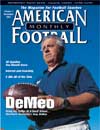AMERICAN FOOTBALL MONTHLY THE #1 RESOURCE FOR FOOTBALL COACHES
Article CategoriesAFM Magazine
|
High fiveMississippi State\'s five db package© More from this issue At Mississippi State, we play with five defensive back all of the time as a part of our base package. We have used this personnel grouping for the last five seasons with great success. It is our opinion that with all of the different formations and personnel groupings offensive coordinators are currently employing, it is in our best interest to be able handle these multiple and varied looks and personnel groupings with our base defensive package. It is our philosophy that the best way to play defense is to make the offense one-dimensional (i.e. stop what they do best). For example, if a team runs the ball extremely well, then we want to force them to throw it, and vice-versa. But, we will not stop with just trying to shut down the opponent's strength. We want to be able go from one play to the next with the procedures and personnel ....The full article can only be seen by subscribers.
|
|
|||||||
| HOME |
MAGAZINE |
SUBSCRIBE | ONLINE COLUMNISTS | COACHING VIDEOS |
Copyright 2025, AmericanFootballMonthly.com
All Rights Reserved





